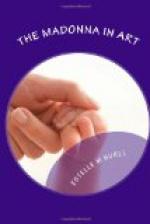The Mater Amabilis is the subject par excellence of modern Madonna art. Carrying on its surface so much beauty and significance, it is naturally attractive to all figure painters. While other Madonna subjects are too often beyond the comprehension of either the artist or his patron, this falls within the range of both. The shop windows are full of pretty pictures of this kind, in all styles of treatment.
There are the portrait Madonnas by Gabriel Max, already mentioned, and pastoral Madonnas by Bouguereau, by Carl Mueller, by N. Barabino, and by Dagnan-Bouveret. Others carry the subject into the more formal compositions of the enthroned and enskied Madonnas, being, as we have seen, not without illustrious predecessors among the old masters. Of these we have Guay’s Mater Amabilis, where the mother leans from her throne to support her child, playing on the step below with his cousin, St. John; and Mary L. Macomber’s picture, where the enthroned Madonna folds her babe in her protecting arms, as if to shield him from impending evil.
[Illustration: BODENHAUSEN.—MADONNA AND CHILD.]
By Bodenhausen we have the extremely popular Mater Amabilis in Gloria, where a girlish young mother, her long hair streaming about her, stands in upper air, poised above the great ball of the earth, holding her sweet babe to her heart.
Pictures like these constantly reiterate the story of a mother’s love—an old, old story, which begins again with every new birth.
CHAPTER VII.
THE MADONNA IN ADORATION.
(THE MADRE PIA.)
The first tender joys of a mother’s love are strangely mingled with awe. Her babe is a precious gift of God, which she receives into trembling hands. A new sense of responsibility presses upon her with almost overwhelming force. Hers is the highest honor given unto woman; she accepts it with solemn joy, deeming herself all too unworthy.
This spirit of humility has been idealized in art, in the form of Madonna known as the Madre Pia. It represents the Virgin Mary adoring her son. Sometimes she kneels before him, sometimes she sits with clasped hands, holding him in her lap. Whatever the variation in attitude, the thought is the same: it is an expression of that higher, finer aspect of motherhood which regards infancy as an object not only of love, but of reverent humility. It is a recognition of the great mystery of life which invests even the helpless babe with a dignity commanding respect.
A picture with so serious an intention can never be widely understood. The meaning is too subtile for the casual observer. An outgrowth of mediaeval pietism, it was superseded by more popular subjects, and has never since been revived. The subject had its origin as an idealized nativity, set in pastoral surroundings which suggest the Bethlehem manger. Theologically it represented the Virgin as the first worshipper of her divine Son. But though the sacred mystery of Mary’s experience sets her forever apart as “blessed among women,” she is the type of true motherhood in all generations.




